 DBM for Spherical Roller Bearing
DBM for Spherical Roller Bearing
Rolling element bearings are incorporated into many rotating machines for their low friction properties. Many different variations are available to accommodate different combinations of radial and axial load as well as misalignment. In order to select the appropriate bearing for a particular application, it is necessary to have a versatile model to simulate the bearing performance.
The dynamic bearing model (DBM) was developed based on the discrete element method to accurately model different types of bearings. The rolling elements, cage, and races are each rigid bodies. Hertzian contact theory governs normal contact between the bearing elements, with several friction models available to determine the friction forces on each element. The forces are combined and used to calculate accelerations based on Newton’s Laws.
In order to increase the capacities of DBM, certain rigid components can be replaced with flexible components. Flexibility is added by discretizing the component into finite elements and explicitly solving for its deformations. This also allows for simulation of more complex systems involving shafts and housings where the deformations of those components affect the dynamic response of the system.
 DBM for Spherical Roller Bearing
DBM for Spherical Roller Bearing
 Cage motion in ball-reference frame
Cage motion in ball-reference frame
MECHANICAL ENGINEERING TRIBOLOGY LABORATORY
Purdue University, West Lafayette, IN 47907 USA, (765) 494-4600